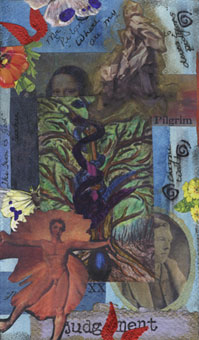XX Judgment
Elizabeth Cherry Owen
Pilgrim
Judgment is a rather puzzling card; often it is necessary to transcend the obvious Rider-Waite-Smith
traditional “second coming” ideas, to realize it is a card of thresholds and possibilities. The moment
depicted here presents a time for personal review and an opportunity for change or movement in a new
direction.
In 1912 a mysterious red haired man named simply Mr. Pilgrim and his companion, Lady Quartermaine,
arrived at the Burgholzli Psychiatric Clinic in Zurich. After numerous suicide attempts, Mr. Pilgrim
has arrived to be treated by Carl Jung. The story of the main character is told through direct
narrative, flashbacks and journal entries; he claims to be immortal and without a specific gender.
He has been a disabled shepherd who encountered the levitating St. Teresa of Avila in a tree, a
stained glass artist at Chartres, the model for the Mona Lisa, and a resident of the famous Cheyne
Walk in Edwardian London. Pilgrim is unspeakably weary and wants to die. Immortality was his punishment
for observing the gods mating in the Tree of Life in the Garden. Finally, there is a sign it may be his
time to go and he escapes Jung’s clinic. He leaves the doctor a note, which contains the central core
of what he has learned on earth:
“My dear Herr Doktor Blockhead,
…The so-called Mysteries have been with us forever. There is not a society on the face of the earth
nor of time that does not and did not have its own version of what these Mysteries reveal of the
Great Spirit, God, the gods and their relationship to our lives – and our lives to theirs. Sun-dancing,
circumcision, birth itself, animal and human sacrifice, virginity, Ra, Raven, Tarot, Voodoo, I Ching,
Zen, totems personal and tribal, the cult of Mary and the cult of Satan – the list is endless. In
modern times, we call such Mysteries art. Our greatest shamans of the moment are Rodin, Stravinsky
(much as I hate his music) and Mann. And what else are they telling us but:
go back and look again.
In time, these shamans will be replaced by others – but all speaking in a single voice. It was ever
thus. But no one listens.”
Through his encounter with Pilgrim, Jung – his imagination freed – comes to believe in his own theory
of the Collective Unconscious. Pilgrim after liberating the Mona Lisa from the Louvre and setting fire
to the Chartres, takes his leave of this earth and is presumably successful.
